Number Patterns Teaching Resources
Explore number patterns in your math classes this school year with fun worksheets, number sequence games and more teacher resources created to help your students understand how numbers in a sequence relate to one another.
Aligned with both TEKS and Common Core math standards, the printable and digital activities in this collection were created by the math teachers on the Teach Starter team to help you save time on your lesson plans.
Whether this is your first year teaching about number patterns or you're just looking for a little extra help, we've got you covered. Read on for a primer from our teacher team! We explain what number patterns are so you can share with your class, plus we explore three common patterns.
What Are Number Patterns? A Kid-Friendly Definition
A number pattern is a series of numbers that each follow the same rule. These patterns or sequences can help us find missing numbers or identify what number will come next in a series.
For example, let's say you are given the following list of numbers:
- 4, 8, 12, 16, 20, 24
This is an example of a number pattern in which the next number in the series is 4 more than the previous number. Once you can identify the pattern in a series of numbers like this one, you can then use that pattern to determine what number comes next or even what numbers could have come before the list began.
This is one of the many reasons number patterns are an important part of building students' algebraic reasoning skills. They help students understand how numbers can be related to one another and apply what they know about those relationships to solve problems.

3 Common Types of Number Patterns
We can't talk about number patterns without breaking down the different types your students are going to encounter in their math journey!
Linear Patterns
Linear patterns are number patterns in which the numbers increase or decrease by the same amount each time.
The example used above — in which each number in the series increased by a quantity of 4 — is a simple example of a linear pattern.
Geometric Number Patterns
Another type of pattern students may have to contend with is the geometric number pattern. This type involves numbers that are multiplied or divided by a constant factor.
The multiplication table is an example of a geometric number pattern.
Recursive Patterns
Students will have to make full use of their understanding of the four whole number operations to work with recursive patterns. That's because this pattern involves finding each successive number in the sequence by performing a specific operation on the previous number(s).
- Plus Plan

Christmas Math Mats - Pattern Block Picture Cards
Print a set of Christmas pattern block picture cards to help children develop shape recognition and fine motor skills.
- Free Plan

Ada Lovelace - Cut and Paste Shapes and Patterns Activity
Explore shapes and patterns with the female programmer, Ada Lovelace, with this cut-and-paste activity for young students.
- Free Plan

Blank Input Output Tables Template Set
Grab this blank input output tables template set to create a wide variety of function table activities that will have your students thinking algebraically.
- Plus Plan

Christmas Printables - Math Skip Counting Puzzles
Grab a set of 10 printable Christmas puzzles to help students skip count in the classroom.
- Free Plan

Counting Mixed Coins Differentiated Worksheets
Download differentiated printable worksheets and use skip counting and addition skills to determine the value of each coin collection.
- Plus Plan

Number Patterns 3rd Grade Worksheet Set
Share our number patterns 3rd grade worksheet set with your students to get them exploring number patterns and algebraic relationships.
- Plus Plan

Escape the Number-Saurus Rex! Number Line Interactive
Escape the Number-Saurus Rex and practice number sequencing skills with an interactive, self-checking math adventure!
- Plus Plan

Dividing and Multiplying by Powers of 10 Game
Play this dividing and multiplying by powers of 10 game to give students practice multiplying and dividing whole numbers by 10, 100, and 1,000.
- Plus Plan

Skip Counting Puzzles
Practice skip counting and identifying multiples of numbers with printable skip counting puzzles for kids.
- Plus Plan

2nd Grade Odd or Even Number Popcorn Sorting Activity
Sort popcorn shaped numbers into either the odd popcorn bucket or the even popcorn bucket.
- Plus Plan

Skip Counting Exit Tickets
Assess student understanding of skip counting within 1000 by 5s 10s and 100s.
- Free Plan

What's Missing? - Ten More, Ten Less Task Cards
Find numbers ten more or ten less than a given two- or three-digit number with this set of 20 task cards.
- Plus Plan
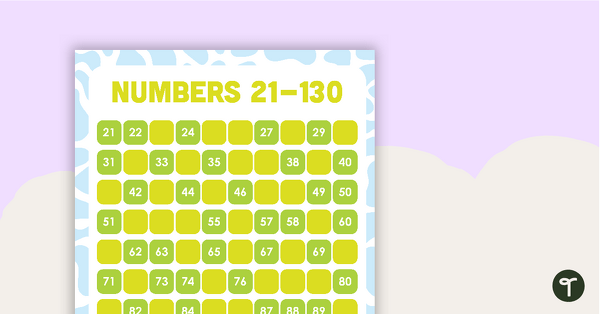
Numbers 21 -130 Chart - Missing Numbers
A 21-130 chart with missing numbers to encourage your students to count beyond 100.
- Plus Plan
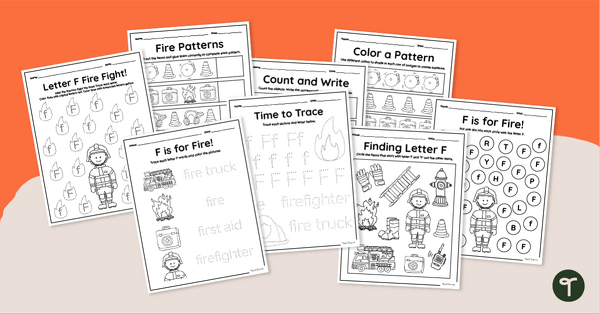
F is for Fire - Letter F Worksheet Pack
Help your PK and K students learn the letter F with 'F is for Fire' Letter F worksheets, which focus on phonetic sounds, handwriting, and activities for early math and literacy.
- Plus Plan

Input Output Tables Worksheet Set
Provide this input output tables worksheet set to your students to give them practice identifying and extending number patterns using all four operations.
- Plus Plan

Input Output Anchor Chart
Hang this input output anchor chart in your classroom to serve as a quick reference during a unit on number patterns.
- Plus Plan

6th Grade Algebra Worksheets
Share these 6th grade algebra worksheets with your students to level up their skills in identifying and extending number patterns.
- Plus Plan

Number Patterns 5th Grade Worksheet Set
Explore algebraic ideas with this number patterns 5th grade worksheet set that provides practice extending whole number, fraction, and decimal patterns.
- Plus Plan

Number Grid Game — Interactive Activity
Share this number grid game with your students to give them practice adding and subtracting ten and one from a given number.
- Plus Plan

Differentiated Number Pattern Worksheets
Practice completing number patterns and determining their rules with this set of differentiated worksheets.
- Plus Plan

Skip Counting to 100 - Card Game
Practice skip counting by 2, 5, and 10 with this card game for small groups.
- Free Plan

Prime and Composite Number Sort
Identify prime and composite numbers by sorting 30 number cards into their proper category.
- Plus Plan
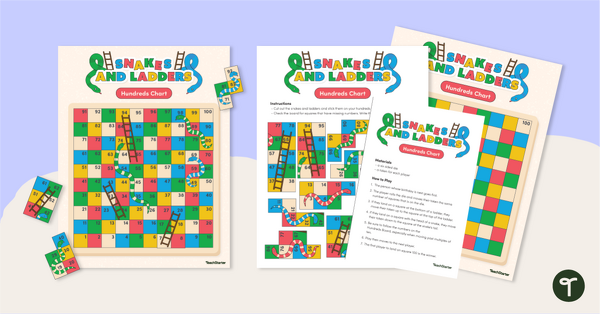
Snakes and Ladders Game - Hundreds Chart
Complete each hundreds chart by putting the missing numbered pieces into place to play a game of Snakes and Ladders.
- Free Plan
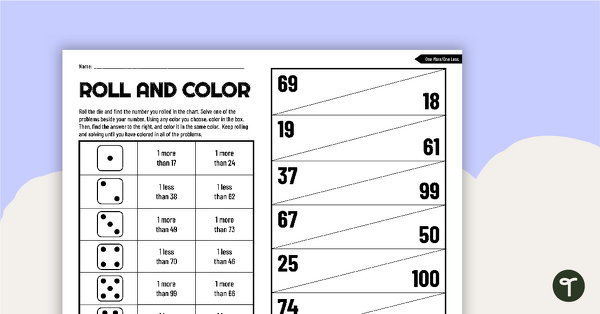
Roll and Color Worksheet - One More, One Less
An interactive worksheet to practice finding the number that is 1 more and 1 less than a given number.
- Plus Plan

One More, One Less Task Cards
Practice identifying one more and one less up to 100 with our set of 24 task cards.
- Free Plan

Skipping Through 120 - Worksheet
A worksheet to practice skip counting by 2s, 5s, and 10s.
- Plus Plan

Ten More, Ten Less Dominoes
Practice adding ten more or subtracting ten from a particular number with a set of 27 dominoes.
- Plus Plan
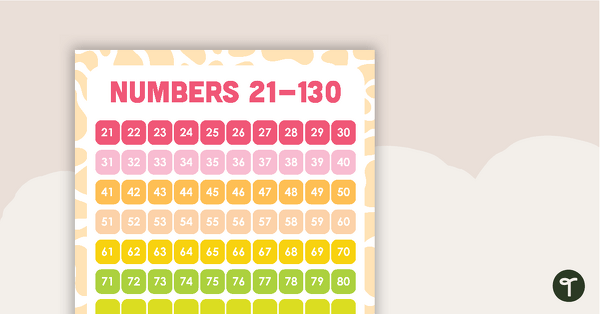
Numbers 21 -130 Chart - Missing Numbers From 80
A numbers 21-130 chart with missing numbers from 80 to encourage your students to count beyond 100.
- Plus Plan

Number Sequencing 1–20 - Worksheet
A worksheet to use when practicing counting from any given number from 0-20.
- Free Plan

Skip Counting by 10s Dominoes
A set of dominoes to use in the classroom when learning to skip count by 10.
- Free Plan

Black and White Number Chart 1–120
A black and white number chart showing the numbers 1-120.
- Plus Plan

One More & Less Worksheet - Thanksgiving Math
Help your students practice finding one more and one less than a number with a printable Thanksgiving One More & Less worksheet.
- Number Patterns Worksheets
- Number Patterns Games
- Number Patterns Posters
- Number Patterns Templates
- Number Patterns for Pre-K
- Number Patterns for Kindergarten
- Number Patterns for 1st Grade
- Number Patterns for 2nd Grade
- Number Patterns for 3rd Grade
- Number Patterns for 4th Grade
- Number Patterns for 5th Grade
- Number Patterns for 6th Grade